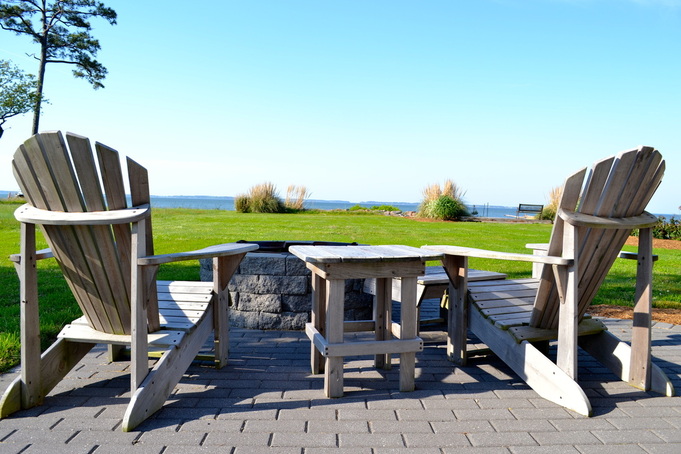History and Information About the Area
Deltaville
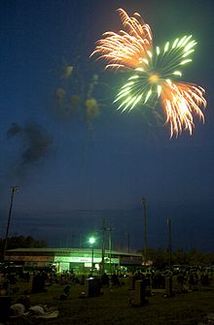
Deltaville is a small unincorporated community on the eastern tip of Middlesex County in the eastern part of Virginia. It is known for being a vacation spot for those looking for sailing, fishing, and other activities associated with the water. Approximately 500-800 full time residents call Deltaville home; however, the town's population swells to several thousand in the summer months. Deltaville is also home to numerous retirees. The town developed around being a large boat building area, mostly for commercial bay watermen. However those days have passed and now the area is dotted with numerous marinas and farms.
Originally known as Union, the community was forced to find a new name in the early 1900s because there was already a Union post office elsewhere in the state. The name Delta was proposed, because of the shape of the town, as it is bordered by the Rappahannock River to the North, the Piankatank River to the south, and the Chesapeake Bay to the east. There was also a Delta, Virginia already in existence, so "ville" was tacked onto the end. The Deltaville zip code is 23043.
Deltaville has been home for over a half century to a semi-pro baseball team, the Deltas. The 1940s vintage Deltaville Ballpark is their home field. Other activities in the town include a town pool, tennis courts, basketball court, and playground, and a community center, all built and maintained by a community association.
The tip end of Deltaville is Stingray Point, which is commonly believed to be named from the early 17th century. According to legend, Captain John Smith was stung by a stingray there while exploring the bay. Captain Smith is said to have given orders to his men for the disposal of his body, before a cure was given to them by local Native Americans, who lived along what is now called Antipoison Creek.
Visit Deltaville's Community Page- http://deltavilleva.com/
Originally known as Union, the community was forced to find a new name in the early 1900s because there was already a Union post office elsewhere in the state. The name Delta was proposed, because of the shape of the town, as it is bordered by the Rappahannock River to the North, the Piankatank River to the south, and the Chesapeake Bay to the east. There was also a Delta, Virginia already in existence, so "ville" was tacked onto the end. The Deltaville zip code is 23043.
Deltaville has been home for over a half century to a semi-pro baseball team, the Deltas. The 1940s vintage Deltaville Ballpark is their home field. Other activities in the town include a town pool, tennis courts, basketball court, and playground, and a community center, all built and maintained by a community association.
The tip end of Deltaville is Stingray Point, which is commonly believed to be named from the early 17th century. According to legend, Captain John Smith was stung by a stingray there while exploring the bay. Captain Smith is said to have given orders to his men for the disposal of his body, before a cure was given to them by local Native Americans, who lived along what is now called Antipoison Creek.
Visit Deltaville's Community Page- http://deltavilleva.com/
Middlesex County
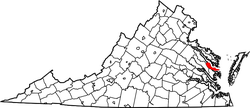
Middlesex County is located at the eastern end of Virginia's Middle Peninsula region. The County is bounded by the Rappahannock River to the north, by the Chesapeake Bay to the east, by the Piankatank River and Dragon Run Swamp to the southwest, and by Essex County to the northwest.
Settlement of the area began around 1640 with the county being officially formed in 1669 from a part of Lancaster County. The county's only incorporated town, Urbanna, was established in 1680 serving initially as a port for shipping agricultural products and later as the county's commercial and governmental center.
Rosegill Estate, a Middlesex County plantation first constructed in 1649, served as the temporary seat of the colony under two royal Governors of Virginia, (Sir Henry Chicheley, who served under Thomas Culpeper, 2nd Baron Culpeper of Thoresway, and Lord Francis Howard, 5th Baron Howard of Effingham). The home remains a private residence to this day, though the estate has been purchased by a Northern Virginia Development firm, and much of it is slated to become a 700 home subdivision. An archaeological survey of the ground underneath the planned development's first phase has revealed what appear to be parts of the Nimcock Native American village, and also parts of the Rosegill slave community.
During the American Civil War, Urbanna was initially planned as the point of landing for General George B. McClellan's 1862 Peninsula Campaign of 1862 to take Richmond, but ultimately, the failed campaign utilized Fort Monroe as its starting point, almost doubling the distance by land to the Confederate citadel. Delays in reaching the gates of Richmond allowed the Confederates ample time to erect substantial defensive batteries, contributing to the Union failure.
The Historic Middlesex County Courthouse was built in 1850-1874 by architects William R. Jones and John P. Hill, and is listed in the National Register of Historic Places. Construction of a new courthouse began in 2003 and was completed in 2004. It was not occupied until September 2007, however, due to a legal dispute between the county and the architect. The Historic Courthouse has been remodeled and now serves as the Board of Supervisors meeting room and the Registrar's Office.
Urbanna was incorporated on April 2, 1902, comprising an area of 0.49 square miles (1.27 km2). The Town of Urbanna remains the county's largest commercial center and its only incorporated area but the county seat of government has moved to the Village of Saluda on U.S. Route 17. To the east, almost to Stingray Point, the Village of Deltaville is situated on State Route 33 between the mouths of the Rappahannock and Piankatank Rivers. Once a major center for wooden boat building, the village remains a commercial and recreational center. The waterfront east to Stingray Point is home to many marinas, with a heavy concentration on Broad Creek.
Middlesex County's Homepage-http://www.co.middlesex.va.us/
Urbanna's Homepage-http://www.urbanna.com/
Settlement of the area began around 1640 with the county being officially formed in 1669 from a part of Lancaster County. The county's only incorporated town, Urbanna, was established in 1680 serving initially as a port for shipping agricultural products and later as the county's commercial and governmental center.
Rosegill Estate, a Middlesex County plantation first constructed in 1649, served as the temporary seat of the colony under two royal Governors of Virginia, (Sir Henry Chicheley, who served under Thomas Culpeper, 2nd Baron Culpeper of Thoresway, and Lord Francis Howard, 5th Baron Howard of Effingham). The home remains a private residence to this day, though the estate has been purchased by a Northern Virginia Development firm, and much of it is slated to become a 700 home subdivision. An archaeological survey of the ground underneath the planned development's first phase has revealed what appear to be parts of the Nimcock Native American village, and also parts of the Rosegill slave community.
During the American Civil War, Urbanna was initially planned as the point of landing for General George B. McClellan's 1862 Peninsula Campaign of 1862 to take Richmond, but ultimately, the failed campaign utilized Fort Monroe as its starting point, almost doubling the distance by land to the Confederate citadel. Delays in reaching the gates of Richmond allowed the Confederates ample time to erect substantial defensive batteries, contributing to the Union failure.
The Historic Middlesex County Courthouse was built in 1850-1874 by architects William R. Jones and John P. Hill, and is listed in the National Register of Historic Places. Construction of a new courthouse began in 2003 and was completed in 2004. It was not occupied until September 2007, however, due to a legal dispute between the county and the architect. The Historic Courthouse has been remodeled and now serves as the Board of Supervisors meeting room and the Registrar's Office.
Urbanna was incorporated on April 2, 1902, comprising an area of 0.49 square miles (1.27 km2). The Town of Urbanna remains the county's largest commercial center and its only incorporated area but the county seat of government has moved to the Village of Saluda on U.S. Route 17. To the east, almost to Stingray Point, the Village of Deltaville is situated on State Route 33 between the mouths of the Rappahannock and Piankatank Rivers. Once a major center for wooden boat building, the village remains a commercial and recreational center. The waterfront east to Stingray Point is home to many marinas, with a heavy concentration on Broad Creek.
Middlesex County's Homepage-http://www.co.middlesex.va.us/
Urbanna's Homepage-http://www.urbanna.com/
The Northern Neck
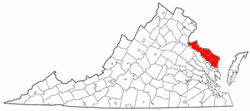
The Northern Neck is the northernmost of three peninsulas (traditionally called "necks" in Virginia) on the western shore of the Chesapeake Bay in the Commonwealth of Virginia. This peninsula is bounded by the Potomac River on the north and the Rappahannock River on the south. It encompasses the following Virginia counties: Lancaster, Northumberland, Richmond, and Westmoreland. The inclusion of King George in the Northern Neck varies among commentators. Historically the grant for the Northern Neck included all land between the Rappahannock and Potomac rivers including far upstream of King George. The boundaries of King George and Westmoreland Counties have changed radically since their establishment with significant exchanges of territory. Significant portions of the early King George lay in what is now Westmoreland county.
In the winter of 1607-08, Captain John Smith traveled up the Rappahannock River as a prisoner of the Powhatans and became the first European known to have visited the Northern Neck. The original Northern Neck land grant in 1661 was a land grant first contrived by the exiled British King Charles II in 1649 and encompassing all the lands bounded by the Potomac and Rappahannock Rivers and, later, by a straight line (the "Fairfax Line") connecting their sources. This grant is significantly larger than the area currently known as the Northern Neck. The original grant was given to a proprietor. Semi-autonomy relative to the colonial government was provided by the proprietarial government until the Revolution. Most of the early development occurred on the eastern end of the peninsula where the Potomac and Rappahannock provided navigable waters. The autonomy and the excellent natural resources that led the richest planters to establish plantations in the Northern Neck. Because of this influx of well-to-do planters an aristocratic society grew earlier than in areas to the south. From this society arose many leaders of the Revolution and the future young republic. These differences created strong antipathies between the regions. Later as the remainder of the mid-Atlantic states became developed, the importance of the Northern Neck would decline and it would enjoy relative isolation. This isolation may be a product of the earlier antipathies related to the differences in society in the Neck and in the regions further south.
A widespread conspiracy was crushed in the Northern Neck in 1687. Slaves in the area planned to kill all whites in the area and escape during a mass funeral. The leaders of the plot were executed. When authorities learned that this was plotted under the cover of gatherings for slave funerals, they prohibited slave funerals. The next year, the Northern Neck was the site of another attempted uprising, this one led by "Sam, a slave of Richard Metcalfe." A repeat offender, he had "several times endeavored to promote a Negro Insurreccon in this Colony." "To deter him & others from the like evil practice for time to come," the court ordered the sheriff of James City County to whip him severely, and return him to the Westmoreland County sheriff to be whipped again. Sam would forever wear "a strong Iron collar affixed about his neck with four sprigs." Should he leave his master's plantation or remove the collar, he would be hanged.
Many important historical figures were born on the Northern Neck, including U.S. presidents George Washington (Westmoreland), James Madison (Port Conway in King George), and James Monroe (Westmoreland), as well as the Civil War general Robert E. Lee and signers of the Declaration of Independence, Francis Lightfoot Lee and Richard Henry Lee. Richard Henry Lee was the sixth President under the Articles of Confederation. Also residing in Westmoreland was Colonel Nicholas Spencer, member of the House of Burgesses, secretary and president of the Governor's Council, and on the departure of his cousin Thomas Colepeper, 2nd Baron Colepeper (aka Lord Culpeper), acting Governor. Vegetable and grain farming and a strong seafood industry once ruled the land. During the Colonial period, the Northern Neck was referred to as the "Athens of the New World" because of its collection of rich landowners dedicated to learning, gentlemanly society, and civic duty. This of course was made possible because of the slave economy in place at that time. Reedville claims to have once been the wealthiest town in the United States, due to its menhaden fishing industry. Before the era of modern highways, many passenger and freight steamer routes linked the entire Chesapeake Bay region and connected with the railroads developed after 1830.
During the American Civil War, Northern Neck and in particularly King George County were on the frontier between the Union and Confederate Armies. As such King George was an operating base for spies on both sides. The Union forces controlled the Potomac River and the north shore of the Rappahannock River further upstream for much of the war.
While trying to elude Union cavalry, co-conspirators John Wilkes Booth and David Herold crossed into the Northern Neck in King George County from Maryland on April 21, 1865 after assassinating US president Abraham Lincoln. Booth and Herold landed at the mouth of Gambo Creek, before meeting with Confederate agents, who guided their passage to Port Conway, Virginia. There, they crossed the Rappahannock River to Port Royal in Caroline County. Booth was killed and Herold captured a short distance away at Garrett's Farm.
Colonial Beach, Virginia, a small incorporated town in Westmoreland County located on the Potomac River waterfront, was a popular tourist spot for the people of the Washington area. It offered a beach, swimming, and gambling. Gambling facilities were actually built on piers extending into the Potomac River so as to ensure they were inside Maryland, as the state border runs along the southern low tide line of the Potomac river. With the end of gambling, Colonial Beach declined in popularity as a tourist destination. It and the rest of the Northern Neck, however, still continue to attract dedicated outdoor enthusiasts for fishing and boating. Monroe Point is a new waterfront townhome community in Colonial Beach offering featuring a private marina and a one mile long nature trail.
The region is rich in scenic beauty, with 1100 miles of shoreline containing beaches, marinas, old steamship wharfs and small towns that date back to colonial times. Today small farms, vineyards and wineries are interspersed with retirement communities and rural businesses that share the land. Since the 1970s wine-making has become an increasingly important vocation in the Northern Neck and the United States, government has established the Northern Neck George Washington BirthplaceAmerican Viticultural Area as a sanctioned wine appellation for wines grown in the five counties. Significant portions of the Rappahannock River National Wildlife Refuge lie in the Northern Neck. It is also home to five state parks/natural areas. These include Caledon Natural Area, Bush Mill Stream Natural Area Preserve, Dameron Marsh Natural area, Westmoreland State Park, and Belle Isle State Park and one national park, the George Washington Birthplace National Monument.
The Northern Neck's Page- http://www.northernneck.org/
The Village of Moratico's Homepage-http://www.morattico.org/
The Town of Kimarnock's Homepage- http://www.kilmarnockva.com/
The Town of Irvington's Homepage- http://www.irvingtonva.org/
In the winter of 1607-08, Captain John Smith traveled up the Rappahannock River as a prisoner of the Powhatans and became the first European known to have visited the Northern Neck. The original Northern Neck land grant in 1661 was a land grant first contrived by the exiled British King Charles II in 1649 and encompassing all the lands bounded by the Potomac and Rappahannock Rivers and, later, by a straight line (the "Fairfax Line") connecting their sources. This grant is significantly larger than the area currently known as the Northern Neck. The original grant was given to a proprietor. Semi-autonomy relative to the colonial government was provided by the proprietarial government until the Revolution. Most of the early development occurred on the eastern end of the peninsula where the Potomac and Rappahannock provided navigable waters. The autonomy and the excellent natural resources that led the richest planters to establish plantations in the Northern Neck. Because of this influx of well-to-do planters an aristocratic society grew earlier than in areas to the south. From this society arose many leaders of the Revolution and the future young republic. These differences created strong antipathies between the regions. Later as the remainder of the mid-Atlantic states became developed, the importance of the Northern Neck would decline and it would enjoy relative isolation. This isolation may be a product of the earlier antipathies related to the differences in society in the Neck and in the regions further south.
A widespread conspiracy was crushed in the Northern Neck in 1687. Slaves in the area planned to kill all whites in the area and escape during a mass funeral. The leaders of the plot were executed. When authorities learned that this was plotted under the cover of gatherings for slave funerals, they prohibited slave funerals. The next year, the Northern Neck was the site of another attempted uprising, this one led by "Sam, a slave of Richard Metcalfe." A repeat offender, he had "several times endeavored to promote a Negro Insurreccon in this Colony." "To deter him & others from the like evil practice for time to come," the court ordered the sheriff of James City County to whip him severely, and return him to the Westmoreland County sheriff to be whipped again. Sam would forever wear "a strong Iron collar affixed about his neck with four sprigs." Should he leave his master's plantation or remove the collar, he would be hanged.
Many important historical figures were born on the Northern Neck, including U.S. presidents George Washington (Westmoreland), James Madison (Port Conway in King George), and James Monroe (Westmoreland), as well as the Civil War general Robert E. Lee and signers of the Declaration of Independence, Francis Lightfoot Lee and Richard Henry Lee. Richard Henry Lee was the sixth President under the Articles of Confederation. Also residing in Westmoreland was Colonel Nicholas Spencer, member of the House of Burgesses, secretary and president of the Governor's Council, and on the departure of his cousin Thomas Colepeper, 2nd Baron Colepeper (aka Lord Culpeper), acting Governor. Vegetable and grain farming and a strong seafood industry once ruled the land. During the Colonial period, the Northern Neck was referred to as the "Athens of the New World" because of its collection of rich landowners dedicated to learning, gentlemanly society, and civic duty. This of course was made possible because of the slave economy in place at that time. Reedville claims to have once been the wealthiest town in the United States, due to its menhaden fishing industry. Before the era of modern highways, many passenger and freight steamer routes linked the entire Chesapeake Bay region and connected with the railroads developed after 1830.
During the American Civil War, Northern Neck and in particularly King George County were on the frontier between the Union and Confederate Armies. As such King George was an operating base for spies on both sides. The Union forces controlled the Potomac River and the north shore of the Rappahannock River further upstream for much of the war.
While trying to elude Union cavalry, co-conspirators John Wilkes Booth and David Herold crossed into the Northern Neck in King George County from Maryland on April 21, 1865 after assassinating US president Abraham Lincoln. Booth and Herold landed at the mouth of Gambo Creek, before meeting with Confederate agents, who guided their passage to Port Conway, Virginia. There, they crossed the Rappahannock River to Port Royal in Caroline County. Booth was killed and Herold captured a short distance away at Garrett's Farm.
Colonial Beach, Virginia, a small incorporated town in Westmoreland County located on the Potomac River waterfront, was a popular tourist spot for the people of the Washington area. It offered a beach, swimming, and gambling. Gambling facilities were actually built on piers extending into the Potomac River so as to ensure they were inside Maryland, as the state border runs along the southern low tide line of the Potomac river. With the end of gambling, Colonial Beach declined in popularity as a tourist destination. It and the rest of the Northern Neck, however, still continue to attract dedicated outdoor enthusiasts for fishing and boating. Monroe Point is a new waterfront townhome community in Colonial Beach offering featuring a private marina and a one mile long nature trail.
The region is rich in scenic beauty, with 1100 miles of shoreline containing beaches, marinas, old steamship wharfs and small towns that date back to colonial times. Today small farms, vineyards and wineries are interspersed with retirement communities and rural businesses that share the land. Since the 1970s wine-making has become an increasingly important vocation in the Northern Neck and the United States, government has established the Northern Neck George Washington BirthplaceAmerican Viticultural Area as a sanctioned wine appellation for wines grown in the five counties. Significant portions of the Rappahannock River National Wildlife Refuge lie in the Northern Neck. It is also home to five state parks/natural areas. These include Caledon Natural Area, Bush Mill Stream Natural Area Preserve, Dameron Marsh Natural area, Westmoreland State Park, and Belle Isle State Park and one national park, the George Washington Birthplace National Monument.
The Northern Neck's Page- http://www.northernneck.org/
The Village of Moratico's Homepage-http://www.morattico.org/
The Town of Kimarnock's Homepage- http://www.kilmarnockva.com/
The Town of Irvington's Homepage- http://www.irvingtonva.org/
The Chesapeake Bay
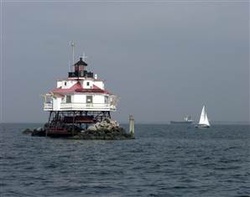
The word Chesepiooc is an Algonquian word referring to a village "at a big river." It is the seventh oldest surviving English place-name in the U.S., first applied as "Chesepiook" by explorers heading north from the Roanoke Colony into a Chesapeake tributary in 1585 or 1586. In 2005, Algonquian linguist Blair Rudes "helped to dispel one of the area's most widely held beliefs: that 'Chesapeake' means something like 'Great Shellfish Bay.' It doesn't, Rudes said. The name might actually mean something like 'Great Water,' or it might have been just a village at the bay's mouth." In contrast with many similar bodies of water, such as Delaware Bay or San Francisco Bay, the Chesapeake Bay is almost always preceded by the article the in usage by people living in the area.
The Chesapeake Bay is the ria, or drowned valley, of the Susquehanna, meaning that it was where the river flowed when the sea level was lower. It is not a fjord, as the Laurentide Ice Sheet never reached as far south as the northernmost point on the bay.
The Bay's geology, its present form, and its very location were created by a bolideimpact event at the end of the Eocene (about 35.5 million years ago), forming the Chesapeake Bay impact crater and the Susquehanna river valley much later. The Bay itself was formed starting about 10,000 years ago when rising sea levels at the end of the last ice age flooded the Susquehanna river valley. Parts of the bay, especially the Calvert County, Maryland coastline, are lined by cliffs composed of deposits from receding waters millions of years ago. These cliffs, generally known as Calvert Cliffs, are famous for their fossils, especially fossilized shark teeth, which are commonly found washed up on the beaches next to the cliffs. Scientists' Cliffs is a beach community in Calvert County named for the desire to create a retreat for scientists when the community was founded in 1935.
On average, the depth of the bay is 21 feet (7 m), including tributaries; over 24% of the bay is less than 6 ft (2 m) deep.
The climate of the area surrounding the bay is primarily humid subtropical, with hot, very humid summers and cold to mild winters. Only the area around the mouth of the Susquehanna River is continental in nature, and the mouth of the Susquehanna River and the Susquehanna flats often freeze in winter. It is exceedingly rare for the surface of the bay to freeze in winter, as happened most recently in the winter of 1976-1977
Since the bay is an estuary, it has fresh water, salt water and brackish water. Brackish water has three salinity zones — oligohaline, mesohaline, and polyhaline. The fresh water zone runs from the mouth of the Susquehanna River to north Baltimore. The saltiest zone and some of the water can be as salty as sea water. It runs from the mouth of the Rappahannock River to the mouth of the bay.
Spanish explorer Lucas Vásquez de Ayllón sent an expedition out from Hispaniola in 1525, led by Captain Pedro de Quejo, which reached the mouth of the Chesapeake and Delaware Bays. It may have been the first European expedition to explore parts of the Chesapeake Bay, which the Spaniards called "Bahía de Santa María" at the time. De Ayllón established a short-lived Spanish mission settlement, San Miguel de Gualdape, in 1526 along the Atlantic coast. Many scholars doubt the assertion that it was as far north as the Chesapeake; most place it in present-day Georgia's Sapelo Island.
Captain John Smith of England explored and mapped the bay between 1607 and 1609. There was a mass migration of southern English cavaliers and their Irish and Scottish servants to the Chesapeake Bay Region between 1640 and 1675. The "Captain John Smith Chesapeake National Historic Trail", the United States' first-ever all-water National Historic Trail, was created in July 2006. The bill passed by voice vote in the House of Representatives and by unanimous consent in the Senate.
The Chesapeake Bay was the site of the Battle of the Chesapeake in 1781, during which the French fleet defeated the Royal Navy in the decisive naval battle of the American Revolutionary War.
The Chesapeake Bay is the ria, or drowned valley, of the Susquehanna, meaning that it was where the river flowed when the sea level was lower. It is not a fjord, as the Laurentide Ice Sheet never reached as far south as the northernmost point on the bay.
The Bay's geology, its present form, and its very location were created by a bolideimpact event at the end of the Eocene (about 35.5 million years ago), forming the Chesapeake Bay impact crater and the Susquehanna river valley much later. The Bay itself was formed starting about 10,000 years ago when rising sea levels at the end of the last ice age flooded the Susquehanna river valley. Parts of the bay, especially the Calvert County, Maryland coastline, are lined by cliffs composed of deposits from receding waters millions of years ago. These cliffs, generally known as Calvert Cliffs, are famous for their fossils, especially fossilized shark teeth, which are commonly found washed up on the beaches next to the cliffs. Scientists' Cliffs is a beach community in Calvert County named for the desire to create a retreat for scientists when the community was founded in 1935.
On average, the depth of the bay is 21 feet (7 m), including tributaries; over 24% of the bay is less than 6 ft (2 m) deep.
The climate of the area surrounding the bay is primarily humid subtropical, with hot, very humid summers and cold to mild winters. Only the area around the mouth of the Susquehanna River is continental in nature, and the mouth of the Susquehanna River and the Susquehanna flats often freeze in winter. It is exceedingly rare for the surface of the bay to freeze in winter, as happened most recently in the winter of 1976-1977
Since the bay is an estuary, it has fresh water, salt water and brackish water. Brackish water has three salinity zones — oligohaline, mesohaline, and polyhaline. The fresh water zone runs from the mouth of the Susquehanna River to north Baltimore. The saltiest zone and some of the water can be as salty as sea water. It runs from the mouth of the Rappahannock River to the mouth of the bay.
Spanish explorer Lucas Vásquez de Ayllón sent an expedition out from Hispaniola in 1525, led by Captain Pedro de Quejo, which reached the mouth of the Chesapeake and Delaware Bays. It may have been the first European expedition to explore parts of the Chesapeake Bay, which the Spaniards called "Bahía de Santa María" at the time. De Ayllón established a short-lived Spanish mission settlement, San Miguel de Gualdape, in 1526 along the Atlantic coast. Many scholars doubt the assertion that it was as far north as the Chesapeake; most place it in present-day Georgia's Sapelo Island.
Captain John Smith of England explored and mapped the bay between 1607 and 1609. There was a mass migration of southern English cavaliers and their Irish and Scottish servants to the Chesapeake Bay Region between 1640 and 1675. The "Captain John Smith Chesapeake National Historic Trail", the United States' first-ever all-water National Historic Trail, was created in July 2006. The bill passed by voice vote in the House of Representatives and by unanimous consent in the Senate.
The Chesapeake Bay was the site of the Battle of the Chesapeake in 1781, during which the French fleet defeated the Royal Navy in the decisive naval battle of the American Revolutionary War.
Also Feel Free to Call Me 804-480-0269
or Email Me
HunterLawRealtor@icloud.com
or Email Me
HunterLawRealtor@icloud.com
*Website Designed by Hunter Law*


